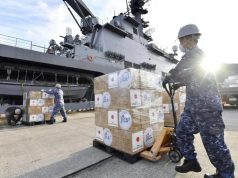
LAOAG, Philippines — U.S. and Philippine armed forces fired missiles and artillery to thwart a simulated invasion in the Philippines‘ northern waters facing Taiwan on Monday, in a show of military force and strengthening ties as regional tensions rise.
About 200 soldiers took turns defending the shores of the coastal city of Laoag in Ilocos province, launching Javelin missiles and firing howitzers and machine guns to repel an unnamed enemy trying to storm the beach.
U.S. and Filipino military personnel sank five floating pontoons standing in for amphibious landing ships as part of their annual exercises called Balikatan, or “shoulder-to-shoulder”.
The annual drills, which involve about 16,000 Filipino and American troops and began last month, will run until May 10. They come at a time of escalating tensions between the Philippines and China in the South China Sea.
READ: Philippines, US troops begin annual combat drills
Last week, the Philippines accused China of using water cannons against their vessels around the disputed Scarborough Shoal, which damaged naval vessels and injured people onboard.
On Monday, Philippine President Ferdinand Marcos Jr said his country would not retaliate in kind, saying the Philippines did not want to raise tensions.
READ: Philippines says won’t raise South China Sea tensions, won’t use water cannons
The exercises have irked China, which has warned of destabilization when countries outside the region “flex muscles and stoke confrontation”.
Several of the drills this year were set in islands and provinces facing Taiwan and the South China Sea. Laoag City is about 408 km (254 miles) from Taiwan’s southernmost point.
‘Not for messaging’
U.S. Marines Lieutenant General Michael Cederholm, commander of joint task force Balikatan, told reporters on Monday the exercises were meant to improve how the forces operate alongside each other and were not directed against a specific adversary.
“We don’t do this for any third party. We don’t do this for messaging. We do this to create interoperability,” Cederholm said, without mentioning China.
The main exercises will culminate with a “maritime strike” on Wednesday, in which the combined forces of the Philippines and the United States will sink a decommissioned Philippine navy ship. The annual drills will officially end on Friday.
Other exercises have included simulations of retaking occupied islands and a multilateral sail with France and Australia in the South China Sea, inside the Philippines‘ exclusive economic zone.
Security engagements between Manila and Washington have increased under Philippine President Ferdinand Marcos Jr., who has allowed Americans to access more Philippine bases under an enhanced defence cooperation agreement, including facilities close to Taiwan and facing the South China Sea.
The United States and Philippines also began joint patrols in the South China Sea last year.
U.S. officials, including President Joe Biden, have affirmed its “ironclad” commitment to defend the Philippines against any armed attack under their 1951 mutual defense treaty.
—Reporting by Mikhail Flores; Editing by Gerry Doyle









